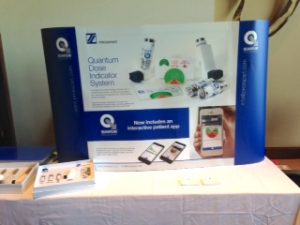The remaining posters selected for the Posters on the Podium included:
- Conor Ruzycki, University of Alberta, “Examining the Effect of Ambient Pressure on Dry Powder Inhaler Performance”
- Larissa dos Reis Gomes
Woolcock Institute of Medical Research and Sydney Medical School, University of Sydney, “Using a Cell-Penetrating Peptide to Enhance pDNA Uptake in Lung Epithelial Cells” - Jan de Backer, FLUIDDA, “Pulmonary Vascular Effects in COPD Subjects after Pulsed Inhaled Nitric Oxide Therapy Evaluated by Functional Respiratory Imaging (FRI)”
- James Hannon, Respira, “TherapeuticsNovel High Efficiency Inhaler for PDE5i Lung Delivery”
- Mark Glusker, Novartis, “USSC-03: A Modular Breath-Actuated Multidose Dry Powder Inhaler System With Telehealth Capability”
Novartis’s announcement of its partnership with Qualcomm to develop data capture capabilities for the Breezhaler DPI earlier this year was just the latest in a series of such pairings within the last year, and whether called “telehealth” or “connected” or “smart” technology, the trend toward inhalers with data collection and management technology was a prominent theme at RDD 2016.
On the podium, David van Sickle of Propeller Health, which announced a partnership with GSK last year, spoke about “Using Connected Devices to Monitor Inhaler Use in the Real World.”
Connected inhaler technology was also prominent In the RDD technology exhibit, where 3M DDS was showing off its brand new Intelligent Controller Inhaler, which includes an integrated screen and an associated app.
 H&T Presspart and Cohero Health were promoting their recently launched connected inhaler. Adherium, which in 2015 announced a deal to provide AstraZeneca with inhaler sensor technology, was promoting its Smartinhaler platform. Electronics appeared even on unconnected devices as in the new eDose counter launched by Aptar Pharma at the meeting.
H&T Presspart and Cohero Health were promoting their recently launched connected inhaler. Adherium, which in 2015 announced a deal to provide AstraZeneca with inhaler sensor technology, was promoting its Smartinhaler platform. Electronics appeared even on unconnected devices as in the new eDose counter launched by Aptar Pharma at the meeting.


